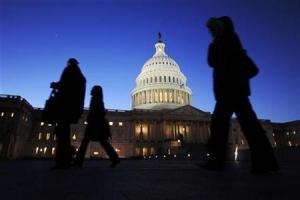
Climate Bill Cost Claims: "Correspondent" Falls Down on Job
It seems that more and more opponents to action on clean energy and climate protection are succumbing to a virus more virulent than swine flu: the inability to tell the truth from fiction Today's episode begins with a blog post by Declan McCullagh, who is billed as a "correspondent" for CBSNews.com (an operation not to be confused with the CBS News of Murrow and Cronkite).
Blogger McCullagh's post is headlined "Obama Admin: Cap and Trade Could Cost Families $1761 a Year." Well, with a headline like that you might think there was a new report by the Obama administration calculating the costs of a cap and trade bill on U.S households. But you would be wrong...
Here is the truth, as old-fashioned as that concept might seem to some.
What blogger McCullagh was actually writing about are five memos written by Treasury department employees that were provided in response to a Freedom on Information request filed by the Competitive Enterprise Institute, a conservative, Washington-based advocacy group. Most of the memos are undated, but some appear to have been written by Treasury Department employees in the final months of the Bush Administration as part of the transition. One must have been written after Obama took office since it refers to a February 2009 speech he made.
To provide suitably sinister mood music, McCullagh leads with a claim that the "Obama administration has privately concluded that a cap and trade law would cost American taxpayers up to $200 billion a year..." (my emphasis) and refers to one of these memos as "a previously unreleased analysis prepared by the U.S. Department of Treasury."
Well, here are the facts:
The first memo referred to by McCullagh is undated but obviously was written after Obama's Joint Congressional Session address of Feb 24, 2009, which is mentioned in the memo. It is one page long and was written by a Treasury Department employee, Judson Jaffe, probably for a higher-up's briefing book. It is neither an analysis nor a summary of one. It contains a statement that if all allowances from a cap were auctioned it "could generate federal receipts on the order of $100 to $200 billion annually." The memo does not assign a household impact cost (because it does not address what might be done with the receipts). Blogger McCullagh is the one who generated the "cost per household" number (by dividing $200 million by about 113 households).
So this memo is not an Obama administration estimate of the impact of a legislative proposal on consumers; it is a simple statement of the revenues that might be received if all allowances in a cap program were auctioned (as Obama's budget was then proposing). Nor was this estimate a secret. At the time the Obama budget was sent up there were numerous back of envelope calculations making estimates of revenues in the same ballpark under the full auction approach.
But the key falsehood in McCullagh's blog is his claim that this memo was an administration estimate of impacts of a climate bill on families. It was nothing of the sort since there was no mention of how the revenues could or would be used to provide benefits to households through tax cuts or other programs to lower energy bills.
In fact, the bills actually before Congress do not employ a 100% auction and they distribute allowance value so that the poorest households actually would have more money in their wallets. According to several credible, non-partisan sources, like the EPA, EIA, and CBO, the average household impact is less than the cost of a postage stamp a day.
The second memo cited by McCullagh is a draft of a transition memo dated 11/6/08, with no author indicated. It states that some future US climate policy could have "economic costs likely on the order of 1% of GDP." Again, this is not an analysis of any policy; just a ballpark indicator of the economic scale of possible climate policies.
The estimate of "on the order of 1%" is a typical number that is thrown around and is in no sense a bombshell.
Other actual analyses have projected total cumulative impacts on GDP over a 30-40 year period at 1% or less. And, what does that size impact mean? It means that 40 years from now the average household will have an income level twice today's average but it will be reached in June of 2050 rather than in January of that year.
***This post originally appeared on the NRDC Switchboard.
Dave Hawkins is the Director of NRDC's climate center based in Washington, D.C.

